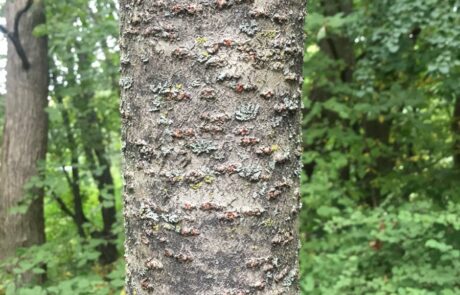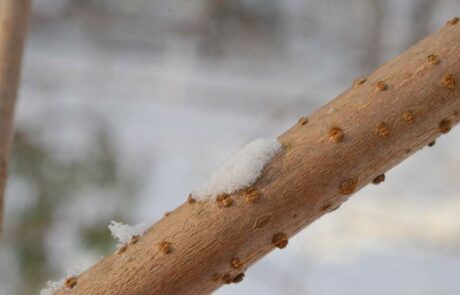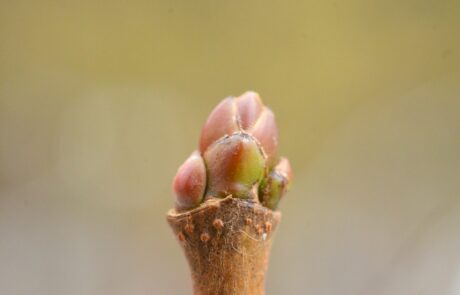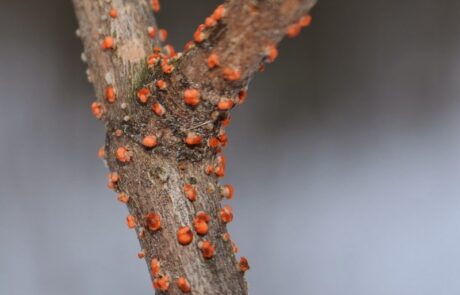Bark is not really a technical term and its simplicity obscures the complexity of a tree’s outer layers. The term is used informally to refer to the layers of tissue (vascular and epidermal) outside of the vascular cambium that are laid down annually by woody perennials (i.e. lianas, trees, and shrubs). If you like the technical details of botany read on, if not, skip ahead to the identification section.
Anatomy of Bark
Those outer layers we think of as bark are the result of SECONDARY GROWTH that occurs in the VASCULAR CAMBIUM, a thin cylinder of undifferentiated meristematic cells that ring a tree (and all of its branches). The tissue actively divides and differentiates to produce secondary xylem and secondary phloem cells. XYLEM cells form on the inside of the vascular cambium and are dead at maturity, becoming wood. Wood is primarily used for structural support, upward transport of water and minerals, and storage of waste. PHLOEM cells form to the outside of the vascular cambium and accumulate as a spongy layer of cells just outside of the wood, known as INNER BARK (unlike wood or outer bark, inner bark does not have discrete annual layers). Inner bark is alive at maturity and essential for actively transporting sugars synthesized by leaves and bark vertically and laterally to the roots and other phloem cells. It also serves as a repository of metabolic waste and defensive chemicals (like tannins and resins).
Because vascular tissue transports sugars and inner bark cells are alive, plants need to protect these tissues from environmental hazards, pathogens, and predators. Most annual plants (like a dandelion) rely on a thin layer of waxy epidermal cells to protect them from these hazards. Since they’re only around for a single growing season, this suffices, but is insufficient for plants with secondary growth. Woody perennials replace the epidermis with a 3-layered PERIDERM to beef up protection from cold, fire, insects, fungi, and everything else trying to break down the castle wall. The first layer, the CORK SKIN (or phelloderm), is a thin layer of green, photosynthetic cells. Scratching a twig often reveals this bright green layer (though it is not present in all species). Cork skin is produced by CORK CAMBIUM (or phellogen), which, like vascular cambium, is a cylinder of undifferentiated, meristematic cells. As cork cambium cells rapidly divide they produce cork skin to the inside and on the outside produce CORK (or phellem) cells. Cork cells are dead at maturity, have lots of air space (insulation) and are impregnated with suberin, which prevents water loss. Wine corks are made from the phellem of cork oak (Quercus suberin).
It can get a bit more complicated, however. The cork skin, cork cambium, and cork collectively make up the periderm. The INITIAL PERIDERM is generated by dermal tissue as a continuous layer. Depending on the species, this initial periderm can last decades before subsequent periderms are produced (as in smooth barked trees, like beech, cherries, birches, musclewood, red maple, oaks, etc; I’m fairly certain this is the reddish bark on young birches) or be replaced within a growing season (e.g. elms, hackberry, ). Successive layers of internal periderm are produced by phellogen (phellos: Greek for cork, and gen as in genesis for birth/production). In some species these subsequent ACTIVE PERIDERM layers may be another layer of continuous initial periderm (as in beech and cherry), while in other species these periderms develop locally, typically near old lenticels, and their pattern of production give different species their characteristic bark texture. When fissures in the bark reveal the active periderm it often has an orange hue to it (as on big-tooth aspen and red oak)
The RHYTIDOME is made of all of the layers of periderm outside of most recently generated periderm (it is not present on species with a persistent initial periderm). The OUTER BARK consists of the rhytidome and cork from the active periderm. If you can nail down these details it starts to make sense how so much variation in bark textures exists. I use a classification system similar to the one detailed by Kim Coder in her paper, Periderm Appearance (PDF)

Tree trunk in cross section, with labeled anatomy
So a quick recap of anatomical features moving from the inside to the outside of a tree:
- Pith
- Wood (Xylem)
- Heartwood
- Sapwood
- Vascular cambium
- Inner bark ( Active phloem)
- Active Periderm
- Cork skin (Phelloderm)
- Cork cambium (Phellogen)
- Cork (Phellem)
- Outer bark
- Cork from active periderm
- Rhytidome
Identification
Because bark immediately interfaces with the myriad selective pressures of the entropic external world, trees have evolved a number of bark adaptations that allow them to thwart/cope with the different pressures (e.g. extreme temperatures, fire, insects, large herbivores, fungal pathogens, etc.). The result is a huge variety of bark morphologies. And lucky for us we can use these different morphologies to ID an individual by bark.
Some species can readily be identified at a distance just from the bark, so familiarizing yourself with this part of a tree is a great way to begin to learn the trees from the forest. What follows are brief descriptions of the different features of bark and galleries of the variation. I split the features of bark into 4 categories. You gotta have a mnemonic for those categories too, so just remember to give Plants TLC:
- Problems: Things ain’t always easy and trees can exhibit symptoms from disease (e.g. burls), stress, or damage (e.g scar tissue)
- Texture: Each tree’s bark has its own texture, ranging from smooth to deeply furrowed. Texture can change over time.
- Lenticels: Openings on the bark allow for gas exchange to facilitate photosynthesis.
- Color: Bark can range in color depending on the season, and is more variable on younger bark.
Bark: Texture
Dick Smythe, who I met while teaching at Sterling College used to say that there are 2 types of bark: smooth and rough. “If you imagine yourself shinnying down a tree with shorts on, then it becomes quite easy to separate the smooth from the rough” (quoted in Marchand’s North Woods). A good starting description for categorizing trees by their bark, but the more you look at bark, the more refined your description can be. As you walk through a Vermont woodland you might start to notice a tree’s bark can be 1) smooth, 2. papery, 3. knobby, 4. furrowed/diamondy, 5. blocky, 6. platey/patchy, or 7. vertically strippy, and a species can exhibit more than one of these qualities, particularly as a tree matures (my scheme overlaps quite nicely with Kim Coder’s scheme for categorizing bark textures).
The bark on most trees starts out smooth (some exceptions are hackberry, bur oak, winged euonymus). As the initial periderm is replaced and the rhytidome forms (see above description of bark), mature bark begins to take form. As the tree continues to grow bark is subject to environmental forces that might break of chunks or the bark is actively shed (as on quaking aspen) and bark can take on a dramatically different appearance. I remember first my first encounter with an old (200+ years) yellow birch was with Dick Smythe on Sterling College’s campus. We paused and he asked me if I knew what tree it was. The bark was coarse and dull brown. I was stumped. No papery strips or horizontal lenticels or any of the features I associate with yellow birch. It was only when I looked up that I could see the characteristic golden, thin papery strips characteristic of yellow birch and persistent catkins. So don’t be afraid to look up!!
The roughness of an individual tree’s bark also depends on how fast the tree grew. An open grown tree will grow faster and have smoother bark than a tree of the same species that grows slower.
Smooth bark (Click to image for gallery)
Smooth bark is relatively common on younger trees, but as the trees age the bark takes a different form. As mentioned above, this is due either to the initial periderm last the life of a tree or for decades before it is replaced by new layers of periderm that give rise to the rhytidome. Only a few of our trees remain smooth at maturity: e.g. aspen, pin cherry, beech, striped maple, and musclewood. Trees that can remain smooth for a couple decades or more (especially on faster growing individuals) include: red maple, Norway maple, bitternut hickory, red oak, sweet birch, basswood, and serviceberry.
Papery bark (Click to image for gallery)
Horizontally peeling papery bark is characteristic of the Betula genus (birches). Some don’t really peel (gray birch and sweet birch), while others peel in large sheets (paper birch) or thin strips (yellow birch), but each has a distinctly smooth and papery quality. Each sheet of paper corresponds to a year of growth. Common buckthorn has dark gray bark that peels into thick, rough strips, and pin cherry – like other cherries – has smooth bark with prominent lenticels, but, unlike the other cherries, it can be peely at maturity. Staghorn sumac has extremely thin bark and once it dies can peel into papery strips, reminiscent of buckthorn or some birches.
Kobby bark (Click to image for gallery)
Knobby bark is definitely one of the less common bark types, and some species appear to have knobby bark but just have very prominently protruding lenticels (like staghorn sumac). Other species (e.g. balsam fir) have blisters on their bark that give them a knobby appearance. Trees with knobby bark include: hackberry and mountain ash.
Furrowed bark (Click to image for gallery)
Furrowed, or fissured bark is one of the more common types for our hardwoods. Somewhat akin in appearance to plow lines, furrows get deeper each year as the rhytidome thickens. Occasionally you can see the active periderm at the base of the furrow (as in red oak and big-toothed aspen); it’s often an orange color. In some species the furrows never become that thick, while on others, deep furrows form. In species with a higher percentage of phloem fibers incorporated in the outer bark, the bark takes on a diamond pattern (as in white ash, boxelder, Norway maple, etc.). Furrows are often similar in appearance to blocky bark. See descriptions of those for differences.
Bark in vertical strips (Click to image for gallery)
Strippy bark splits into long vertical plates that curl up away from the trunk. Some peel enough to stuff a squirrel under (shagbark hickory) while others peel in tinier strips (like hophornbeam). While they should probably have their own category, I include the fibrous barked cedars (eastern redcedar and northern white cedar) in this group.
Blocky bark (Click to image for gallery)
Blocky bark is common on lots of trees. These trees essentially have the vertically furrows, but these are broken horizontally at regular intervals. This can get a bit murky in something like black walnut which essentially has diamond furrowed bark, but these furrows are broken horizontally so the diamonds often look like a “V” or “Y”. Blocky-ness is a distinguishing characteristic between the otherwise very similar red and black oaks. Red oak furrows run continuously up the trunk like ski tracks on fresh powder, whereas black oak furrows are interrupted into little blocks. Block bark tends to be really beautiful in cross-section. It’s common in most conifers (not in Cupressaceae).
Plates, Patches, and Circles (Click to image for gallery)
A bit of a hodgepodge category as the shape of the new phellogen being formed determines what the fracture pattern will look like. New phellogen is laid down locally as older layers of periderm break down. The shape of these localized patches of new periderm can be shaped like a lens, arc, scales, etc. The resultant bark can look like camouflage plates (red pine or American sycamore), potato chips (black cherry), or relatively even circles (red spruce).
Lenticels
Transporting materials up a tree via xylem (wood) is a passive process for the wood. It’s controlled by the stomata in the leaves opening up to let water evaporate out which draws up the entire water column (cool video here). Transporting materials up and down the trunk through the phloem, however, is an active process. It requires O2 to fuel the work of cells within the bark. Having lenticels – little mouth holes – on the bark allows the tree to exchange gases with the environment. Moisture can also escape through the lenticels, so trees have to balance the need to exchange gases with the need to conserve water.One unfortunate side effect of having bark is that it gets thicker and thicker with each year (a la adding new periderm). As the bark thickens lenticels are eventually blocked up and no longer function as efficiently. Having outer layers of the rhytidome slough off allows a tree to maintain active lenticels as it ages. Sycamore does this by sloughing off plates (these plates sequester air pollution and so London planetree makes for a great urban street tree), paper birch does this by shedding papery sheets, and aspen does this my having bark that turns to a powder and washes off with rain.
Within a species there is variation in the density of lenticels on the upper side as compared to the underside of the twig. There’s also a correlation between moisture levels in the soil and density of lenticels.
** Note for ID ** I actually don’t find lenticels to be helpful at all for ID except in the case of the cherries. Though in some trees they’re one of the more prominent features and so might jump out at you as the first recognizable trait, so always good to be familiar with their variation.
There are only so many ways to make a hole! But combine this with color, size, and abundance and there’s quite a bit of variability from one species to another. Lenticel shapes can be:
- Horizontally linear: Common to birches and cherries.
- Punctate: Small round holes
- Vertical (glossy buckthorn)
- Diamond shape: Quaking aspen (as it gets older the diamonds look like the studs on a studded belt)
Bark Color
Color is created by pigments, which are created by the plant. Since the color is based on a physical component of a tree we can use these colors to understand the ecology of a tree and specialized adaptations a tree may have to compete for resources. On some trees, break a chunk of the bark and looking at it in cross section reveals unweathered colors like oranges (black cherry), purples (hemlock), or white/orange bands (American elm). While a proper discussion of bark color does belong here, I’ve left it for the section on Twigs & Buds because most bark as it matures loses the vibrancy of its colors and so really only has non-brownish colors for the first 1-3 years of growth before the intial periderm is replaced. What follows is an overview of colors with an emphasis on bark, but I include details on other parts of a tree so I could get the whole ROYGBIV thing in there.
- Brown: Lignin, a structural molecule that makes up the bulk of cell walls, has a brownish color. It’s not surprsing that the bulk of tree bark has a brownish cast to it.
- Reds: Tannins can give bark a reddish brown color.
- Orange: The upper section of Scots pines are a brilliant orange – like the tasty insides of a Butterfinger.
- Yellow: A common color in Salicaceae (willow, aspen family), but most prominent in twigs of Weeping willow. Quaking aspen can take on a distinctly yellow color in winter.
- Green: Green comes from the phelloderm, a photosynthetic layer in the periderm. Photosynthetic bark is pretty much the rule on younger parts of a tree where the bark is thin enough to allow some light to reach the phelloderm (younger white pine bark in particular has a white green color). Some trees actively maintain thin bark (aspen), even at maturity, to maintain the bark’s photosynthetic capabilities.
- Blue: Blue really only exists on berries (e.g. dogwood) and is a signal to frugivores that their berries are ripe.
- Purples: Anthocyanins are a class of pigments (red to purple in color) that minimize ultraviolet radiation damage to plant tissue. Areas of a tree exposed to direct sunlight produce anthocyanins, while shaded parts don’t (like the top vs bottom of an alternate-leaf dogwood branch; this pattern is particularly prominent on raspberry canes).
- White: Albedo is the measurement of the reflectivity of a surface. White shiny surfaces have a higher albedo than dark dulls ones, and on a sunny winter day I’d rather be wearing a black fleece than a white garbage bag. For a deciduous tree in the far north its the opposite, and indeed the farther north you go the more successful are trees with white bark (poplars/aspens, paper birch). White bark helps trees avoid frost cracking by reducing expansion/contraction associated with heat change.
Problems: Disease, Deformity, and Damage
Trees can’t migrate, build a burrow, or run away to avoid damage or death. But they’re not helpless and have a multitude of defenses at their disposal to protect them from the elements. But nobody’s perfect and sometimes a cold snap hits that a tree hasn’t “hardened off” for winter yet (check out Winter: An Ecological Handbook for more on hardening), or a 100-year wind storm ravages a forest, or a flood sends ice chunks rafting down a stream, or a beaver moves in next door, or any number of other potential bad things happen. The response elicited in the tree is unique to that species and often leaves behind characteristic signs.
Not all problems are caused by external forces. Sometimes the odd growth on a tree is actually the result from the internal process of self-pruning. The result is particularly prominent in rot-resistant trees. The process is pretty straightforward: a lower branch gets shaded out by the tree’s canopy. The limb becomes an energy sink, no longer producing more energy than it costs to maintain. The tree cuts of the branch from its roots and the branch slowly dies. The branch begins to decompose, eventually falling off. The tree produces callus wood that will heal over where the branch fell off. These branch scars eventually disappear if the branch was small or if it fell off quickly (these are the knots you see in lumber). However, in rot resistant wood the dead limb can stay on the tree for many years while callus tissue slowly grows out along its length forming a knobby protrusion. This is common in oaks and hophornbeams (which I call knob-hornbeam). Flip through the gallery to see some prominent signs of problems on our native trees.
There’s no end to the problems that trees face. But a few are widespread and can be diagnostic of a species. The Nectria fungus attacks only American beech. Phamopsis galls form only on Bitternut Hickory. The gaping wounds caused by the sugar maple borer only torment the sugar maple. Target canker is unique to red maple. The signs left behind are obvious enough that they can be helpful identification tools
- Galls (from insects)
- Burls (from fungi, viruses, bacteria)
- Wounds (from beaver, bark boring beetles, pileated woodpeckers)
- Callus growth (from old branches)
- Epicormic branches (from mechanical damage, common in fire and flood adapted species)

































